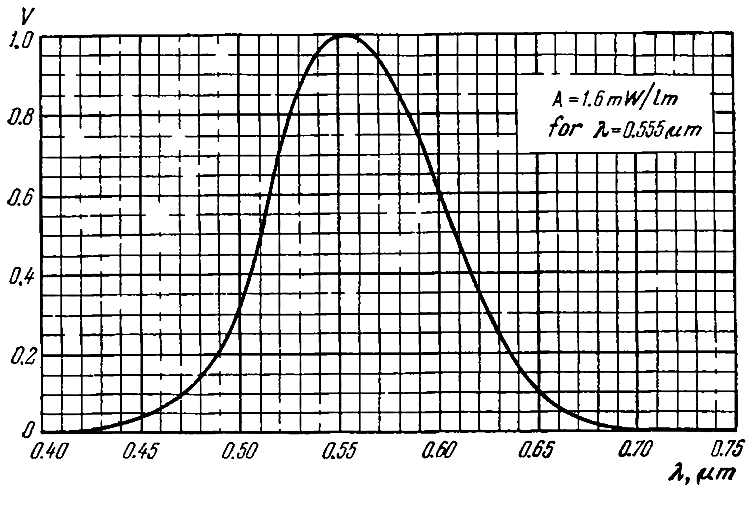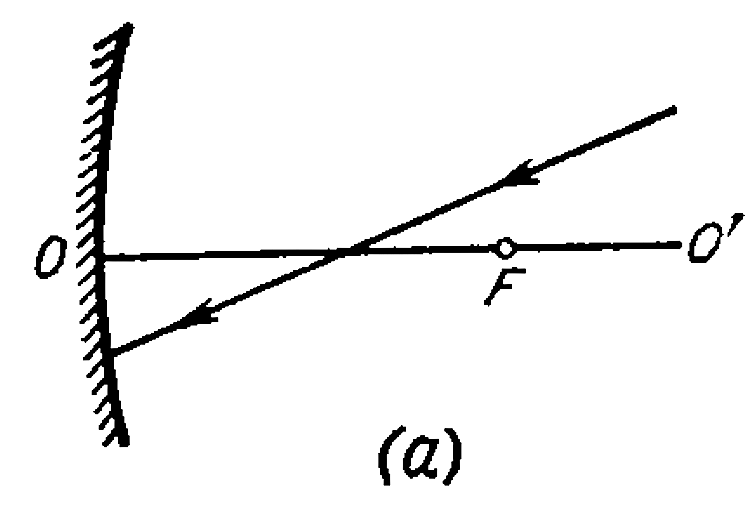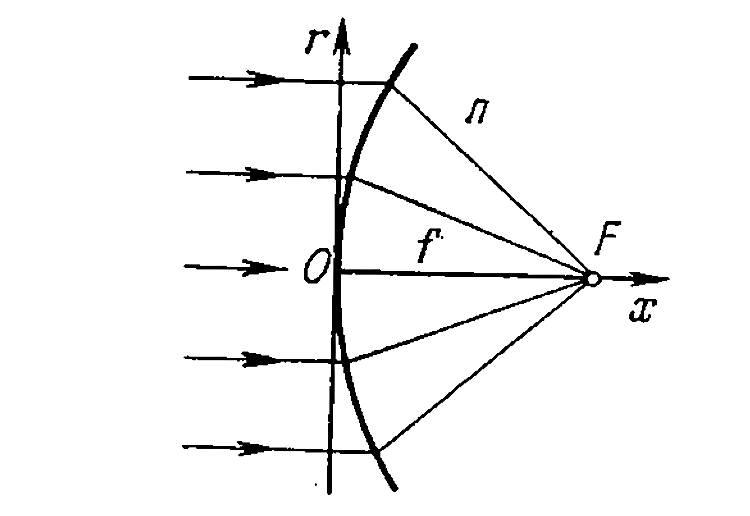Photometry And Geometrical Optics from IE IRODOV PHYSICS Chapter 9 OPTICS for Class 12
| Class 12 | PHYSICS |
| Chapter | OPTICS |
| IE IRODOV PHYSICS | Photometry And Geometrical Optics |
| Medium | English |
| Academic Year | 2023-2024 |
Question 1
Making use of the spectral response curve for an eye (see Fig.), find :
(a) the energy flux corresponding to the luminous flux of 1.01m at the wavelength 0.51 and 0.64μm,
(b) the luminous flux corresponding to the wavelength interval from 0.58 to 0.63μm if the respective energy flux, equal to Φ=4.5mW, is unifromly distributed over all wavelengths of the interval. The function V(λ) is assumed to be linear in the given spectral interval.
 View Solution
View SolutionQuestion 3
Find the mean illuminance of the irradiated part of an opaque sphere receiving
(a) a parallel luminous flux resulting in illuminance E0 at the point of normal incidence,
(b) light from a point isotropic source located at a distance l=100cm from the cnetre of the sphere, the radius of the sphere is R=60cm and the luminous intensity is I=36cd.View SolutionQuestion 6
An illuminant shaped as a plane horizontal disc S=100cm2 in area is suspended over the centre of a round table of radius R=1.0m. Its luminance does not depend on direction and is equal illuminant be suspended to provide maximum illuminance at the circumference of the table ? How great will that illuminance be? The liuminant is assumed to be a point source.View SolutionQuestion 7
A point source is suspended at a hight h=1.0m over the centre of a round table of radius R=1.0m. The luminous intensity I of the source depends on direction so that illuminance at all points of the table is the same. Find the function I(θ), where θ is the angle between the radiation direction and the vertical, as well as the luminous flux reaching the table if I(0)=I0=100cd. View SolutionQuestion 8
A vertical shaft of light from a projector forms a light spot S=100cm2 in area on the celling of a round room of radius R=2.0m. The illuminance of the spot is equal to E=10001x. The reflection coeffiecient of the celling is equal to ρ=0.80. find the maximum illuminance of the well produced by the light reflected from the celling. the reflection is assumed to obey Lambert's law. View SolutionQuestion 16
Two optical media have a plane boundary between them. Suppose θ1cr is the critical angle of incidence of a beam and θ1 is the angle of incidence at which the refracted beam is perpendicular to the reflected one (the beam is assumed to come from an optically denser medium). Find the relective index of these media if sinθ1cr/sinθ1=η=1.28. View SolutionQuestion 18
A man standing on the bottom. The depth o fthe swimming pool looks at a stone lying on the bootom. The depth of the swimming pool is equal to h. At what distance from the surafce of water is the image of the stone formed if the line of vision makes an angle θwith the normal to the surface?View SolutionQuestion 24
A light ray composed of two monochromatic components passes through a trihedral prism with refracting angle θ=60∘. Find the angle Δα between the components of the ray after its passage through the prism if their respective indies of refraction are equal to 1.515 and 1.520. the prism is oriented to provide the least deflection angle.View SolutionQuestion 26
By means of plotting find :
(a) the path of a light ray after reflectin from a concave and convex spherical mirrors (see Fig. where F is the focal point, OO' is the optical axis) ,

(b) the positions of the mirror and its focal point in the cases illunstrated in Fig. where P and P' are the conjugate points.
 View Solution
View SolutionQuestion 27
Determine the focal length of a concave mirror if:
(a) with the distance between an object and its image being equal to l=15cm, the transverse magnification β=02.0,
(b) in a certain position of the object the transverse magnification is β1=−0.50 and in another position displaced with respect to the former by a distance l=5.0cm the transverse magnification β2=−0.25.View SolutionQuestion 30
A parallel beam of light falls from vacuum on a surface enclosing a medium with refractive3 index n (Fig.) Find the shape of that surface, x(r) if the beam is brought into focus at the point F at a distance f from the crest O. What is the maximum radius of a beam that can still be focussed ?
 View Solution
View SolutionQuestion 32
An object is placed in front of convex surface of a glass plano-convex lens of thickness d=9.0cm. The image of that object is formed on the plane surface of the lens serving as a screen. Find:
(a) the transverse magnification if the curvature radius of the lens's convex surface is R=2.5cm,
(b) the image illuminance if the luminance of the object i sL=7700cd/m2 and the entrance apertune diameter of the lens is D=5.0mm, losses of light are negligible.View SolutionQuestion 33
Find the optical power and the focal lengths
(a) of a thin glass lens in liquid with refractive index n0=1.7 if its optical power in air is Φ0=5.0D,
(b) of a thin symmetrical biconvex glass lens, with air on one side and water on the other side, if the optical power of that lens in air is Φ0=+10D.View SolutionQuestion 34
By means of plotting find :
(a) the path of a ray of light beyound thin converging and diverging lenses (Fig. where OO' is the optical axis, F and F' are the front and rear focal points),

(b) the position of a thin lens and its focal points if the position of the optical axis OO' and the positions of the cojugate3 points P,P (see Fig.) are knows , the media on both sides of the lenses are identical,
(c ) the path of ray 2 beyond the converging and diverging lenses (Fig. ) if the path of ray 1 and the positions of the lens and of its

optical axis OO' are all known, the media on both sides of the lenses are identical.View SolutionQuestion 35
A thin converging lens with focal length f=25cm projects the image of an object on a screen removed from the lens by a distance l==5.0m. Then the screen was draws closer to the lens by a distance Δl=18cm. By what distance should the object be shifted for its image to become sharp again ?View SolutionQuestion 36
A source of light is located at a disatnce l=90cm from a screen. A thin converging lens provides the sharp image of the source when placed between the source of light and the screen at two positions. Determine the focal length o fthe lens if
(a) the distance between the two positions of the lens is Δl=30cm,
(b) the transverse diamensions of the image at one position o fthe lens are η=4.0 greater than those at the pther position.View SolutionQuestion 38
A thin converging lens with aperture ratio D:f=1:35(D is the lens diameter, f is its focal length) provided the image of a sufficiently distance object on a photographic plate. The object luminance is L=260cd/m2. The losses of light in the lens amount to α=0.10 . Find the illuminance of the image. View SolutionQuestion 40
There are two thin symmetrical lenses : one is converging , with refractive index n1=1.70, and the other is diverging with refractive index n2=1.51. Both lenses have the same curavature close together and submerged into whater. What is the focal length of this system in water ?View SolutionQuestion 42
Figure illustrates an aligned system consisting of three thin lenses. The system is located in air. Determine:

(a) the position of the point of convergence of a parallel incoming from the left after passing through the system,
(b) the distance between teh first lens and a point lying on the axis to the left of the system, at which that point and its image are located symmetrically with respect to the lens system.View SolutionQuestion 46
A Keplerian telescope with magnification T=15 was submerged into water which filled up the inside of the telescope. To make the system work as a telescope again within the former dimensions, the objective was replaced. What has the magnification of the telescope become equal to ? the refractive index of the glass of which the ocular is made is equal to n=1.50.View SolutionQuestion 47
At what magnification T of a telescope with a diameter of the objective D=6.0cm is the illuminance of the image of an object on the retina not less than without the telescope ? The pupil diameter is assumed do be equal to d0=3.0mm. The losses of light in the telescope are negligible.View SolutionQuestion 48
The optical powers of the objective and the ocular of a microscope are equal to 100 and 20D respectively. The microscope magnification is equal to 50. What will the magnification o fthe microscope be when the distance between the objected and the ocaular is increased by 2.0cm?View SolutionQuestion 49
A microscople has numberical apertune sinα=0.12, where α is the aperture angle subtended by the entrance pupil of the microscope. Assuming the diameter of an eye's pupil to be equal to d0=4.0mm determine the microscope magnification at which
(a) the diameter of the beam of light coming from the microscope is equal to the diameter of the eye's pupil,
(b) the illuminance of the image on the retina is independent of magnification (consider the case when the beam of light passing through teh sysytem ''microscope-eye'' is bounded by the mounting of the objective). View SolutionQuestion 51
An optical system is located in air. Let OO' be its optical axis, F' and F' are the front and rear focal points, H and H' are the front and rear principle planes, P and P' are the conjugate points. By means of plotting find:
(a) the position F' and H' (Fig.),
(b) the position of the point S' conjugate to the point S (Fig.),

(c) the positions F,F', and H' (Fig. where the path of the ray of light is shown before and after pasing through the system).View SolutionQuestion 53
A telephoton lens consists of two lenses, the front converging lens and the rear diverging lens with optical power Φ1=+10D and Φ2=−10D. Find:
(a) the focal length and the positions of principle axes of that system if the lenses are seperated by a distance d=4.0cm, (b) the distance d between the lenses at which the ratio of a focal length f of the system to a distance l between the converging lens and the rear principle focal points is the highest. what is this ratio equal to ?View SolutionQuestion 55
An aligned optical system consists of two thin lenses with focal lengths f1 and f2, the distance between the lenses being equal to d. The given system has to be replaced by one thin lens which, at any position of an object, would provide the same transverse magnification as the system. what must the focal length of this lens be equal to and in what position must it be placed with respect to the two-lens system?View SolutionQuestion 56
A system consists of a thin symmetrical converging glass lens with the curvature radius of its surfcaes R=38cm and a plane mirror oriented at right angles to the optical axis of the lens. What is the optical power of this system when the space between the lens and the mirror is filed up with water ? View SolutionQuestion 57
At what thickness will a thick convex-cancave glass lens in air
(a) serve as a telescope provided the curvature radius of its convex surface is ΔR=1.5cm greater than that of its concave surface?
(b) have the optical equal to −1.0D if the curvature radii of its convex and concave surfaces are equal to 10.0 and 7.5cm respectively ?View SolutionQuestion 58
Find the poistions of the principle planes, the focal length and the sign of the optical power of a thick convex-concave glass lens
(a) whose thickness is equal to d and curvature radii of the surfaces are the same and equal to R,
(b) whose refractive surfaces are concentric and have the curvarure radii R1 and R2(R2>R1). View SolutionQuestion 61
A ray of light propagating in an isotropic medium with refractive index n varying gradually from point to points has a curvature radius ρ determined by the formula
1ρ=∂∂N(Inn),
where the derivative is taken with respect to the principle normal to the ray. Derivethis formula, assuming that is such a medium the law of refraction nsinθ= const holds. Here θ is the angle between the ray and the direction of the vector Δn at a given point.View SolutionQuestion 62
Find the curvature radius of a ray of light propagating in a horizontal direction close to the Earth's surface where the gradient of the refractive index in air is equal to approximately 3.10−8m−1. At what value of that gradient would the ray of light propagate all the way round the Earth? View Solution
